Biodiversity, Evolution and Disease
1/87
There's no tags or description
Looks like no tags are added yet.
Name | Mastery | Learn | Test | Matching | Spaced |
|---|
No study sessions yet.
88 Terms
What diseases are caused by bacteria? What are the symptoms, and how are they transmitted, treated and prevented?
Tuberculosis infects the lungs
Coughing blood, weight loss, high temperature
Airborne
Treated by antibiotics
Prevented by vaccinations
Meningitis inflammes the tissue surrounding the brain and spinal cord (meninges)
High temperature, headache, rash, neck stiffness
Transmitted through contact and the air
Treated by antibiotics
Prevented by vaccinations
Ring rot infects potato and tomato plants
Wilting, discolouration, vascular tissue rots and turns black
Transmitted through contact
No cure
Prevented by using clean equipment and destroying infected plants
What diseases are caused by fungi? What are the symptoms, and how are they transmitted, treated and prevented?
Black sigatoka affects banana plant leaves
Black/brown streaks and leaf death
Transmitted by spores and through rain splashes
Treated by fungicides
Prevented by fungicides, keeping space between trees and removing affected leaves
Ringworm infects cattle
Grey ring shaped rashes
Transmitted through contact
Treated by anti-fungal creams
Prevented by reducing overcrowding
Athlete’s foot affects feet in humans
Cracking and scaling, itchy skin between toes
Transmitted by contact
Treated by anti-fungal creams
Prevented by keeping feet clean and dry, avoiding public showers and swimming pools
What diseases are caused by protoctists? What are the symptoms, and how are they transmitted, treated and prevented?
Malaria damages the red blood cells, liver and brain
Nausea, vomiting, fever, chills, headache, fatigue
Transmitted by anopheles mosquito vectors
Treated by antimalarial medicine
Prevented by antimalarial medicines, insect repellents, mosquito nets and avoiding stagnant water
Potato blight is a fungus-like protoctist that damages potato and tomato crops
Small, brown rotting spots on leaves, decaying tubers
Transmitted by spores
No cure
Prevented by removing infected plants, using resistant strains and fungicides
What diseases are caused by viruses? What are the symptoms, and how are they transmitted, treated and prevented?
Tobacco mosaic virus damages many plant species
Stunted growth, yellow mosaic patterns on leaves
Transmitted by contact
No cure
Prevented by removing infected plants, using resistant varieties and disinfecting tools
Influenza A, B and C damage ciliated epithelial cells
High temperatures, coughing, headache, fatigue
Transmitted by airborne droplets that can stay on surfaces
Treated by antiviral drugs and rest
Prevented by vaccines and good hygiene
HIV is a virus that damages the immune system and can lead to AIDS
Flu-like symptoms that disappear
Transmitted through bodily fluids
No cure but can be treated by antiretroviral medicines
Prevented by using condoms, abstinance, not sharing needles, post and pre-exposure medicines
What are the two types of disease transmission?
Direct - from one host to another host
Indirect - a second organism (vector) that is unaffected by the pathogen transfers it to a new host
What are the methods of direct disease transmission?
Contact- skin-skin or contact with bodily fluids
Inoculation- through a wound
Droplets- infected droplets come into contact with a person
Fungal spores- travel through the air
Vertical transmission- from mother to baby during pregnancy
What are the methods of indirect disease transmission?
Vectors- an infected host (ie. insect) carries disease from one organism to another
Airborne- infected droplets are inhaled after being suspended in the air
Fomites- inanimate objects carrying diseases
Food and waterborne- ingestions of contaminated food and water
What factors can affect disease transmission in animals?
Overcrowding (close proximity)
Poor nutrition
Compromised immune system (HIV/AIDs/taking immunosuppressants)
Poor waste disposal
Climate change (certain animal vectors prefer different climates)
Lack of public awareness/doctors
Migration
Certain unsanitary cultural traditions
What factors can affect disease transmission in plants?
Overcrowding (density of planting)
Disease resistance
Poor soil nutrition
Climate change
Wind strength
Farming practices
Water/soil contamination
What non-specific passive physical defences are present in plants?
Waxy cuticle on leaves
Cellulose cell walls
Lignified bark
How do plants detect pathogen attack?
Receptors in the cell membrane recognise molecules from the pathogen and chemicals produced by attack of the cell wall
Signalling molecules switch on genes in the nucleus
This triggers the production of defensive chemicals, substances to act as physical barries, and signals to trigger the defences of nearby cells
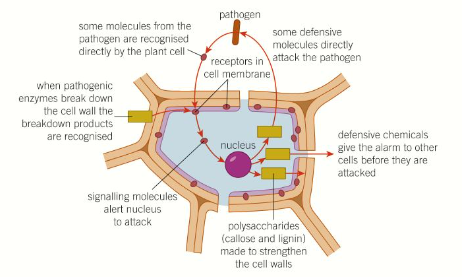
What physical defenses can be triggered in plants due to attack?
Callose, a polysaccharide of beta glucose monomers, is produced, which is deposited between cell walls, sieve tube pores, and in the plasmodesmata connecting cells, and blocks further spread of the pathogen to other cells and parts of the plant
Lignin is added to cell walls to strengthen and thicken them
Stomata can be closed to prevent further attack
What chemical defenses can be triggered in plants due to attack?
Insect repellants eg. pine resin and citronella
Insectides eg. pyrethrins (neurotoxin in chrysanthemums) and caffeine
Antibacterial compounds eg. phenols, gossypol (in cotton), defensins and lysosomes
Antifungal compounds eg. phenols, gossypol, caffeine, saponins and chitinases (break down fungal cell walls)
Toxins eg. cyanide
Often we extract these substances, as they are useful to us for pathogen defence, as well as herbs and spices
Why are plants unique in their pathogen response?
Oftentimes plants don’t try to heal tissues damaged by disease, they just section it off and sacrifice it (leaf drop/necrosis/abscission)
What non-specific defenses are present in animals?
Skin
Mucous membranes lining gas exchange surfaces
Chemical defenses (stomach acid + lysosomes in tears and urine)
Blood clotting + wound repair
Inflammation
Expulsive reflexes (coughing, sneezing and vomiting)
How does the skin defend against pathogens?
Physical barrier
Secretes sebum, which inhibits pathogen growth
Has a natural population of bacteria that out-compete pathogens
How do mucous membranes defend against pathogens?
Goblet cells secrete mucus (containing lysosomes) that traps + destroys pathogens
Cilia waft pathogens towards the throat to be coughed out
How do blood clotting + wound repair defend against pathogens?
Platelets at a wound release thromboplastin and serotonin
Thromboplastin triggers a clotting reaction cascade
This causes the soluble protein fibrinogen to be converted to insoluble fibrin, forming a scab
Serotonin reduces the supply of blood to the area
The scab formed acts as a physical barrier while epidermal cells grow underneath and collagen reinforces the skin
How does inflammation defend against pathogens?
Mast cells release histamines and cytokines
Histamines dilate the blood vessels (causing redness and heat that prevents pathogens reproducing) and increase membrane permeability (causing tissue fluid to escape resulting in swelling and pain)
Cytokines attract phagocytes to the site to destroy pathogens (eg. interleukins)
What are the types of white blood cells and what do they do?
Phagocytes- non-specific immune response of engulfing pathogens, by phagocytosis (includes neutrophils and macrophages)
Lymphocytes- specific immune response of producing antibodies, killing pathogens and regulating of the immune response (includes T and B lymphocytes)
What is the process of phagocytosis by neutrophils?
Neutrophils recognise an antigen from a pathogen as being foreign or ‘non-self’
They engulf the pathogen in a vacuole, to form a phagosome
Lysosomes bind to the phagosome to form a lysophagosome
The enzymes in the lysosomes break down the pathogen
The products of this are removed from the cell by exocytosis
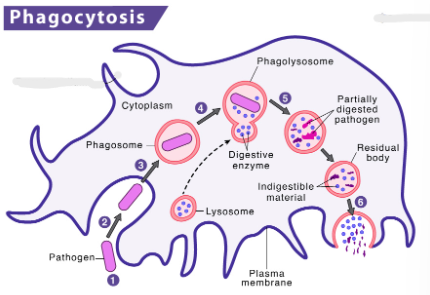
What is the process of phagocytosis by macrophages?
Macrophages recognise an antigen from a pathogen as being foreign or ‘non-self’
They engulf the pathogen in a vacuole, to form a phagosome
Lysosomes bind to the phagosome to form a lysophagosome
The enzymes in the lysosomes break down the pathogen
The products of this bind to the antigens from the macrophage, to form a major histocompatibility complex (MHC) in the cytoplasm
The macrophage then displays these antigens on the cell membrane to become an antigen-presenting cell, which will stimulate lymphocytes in the specific immune response
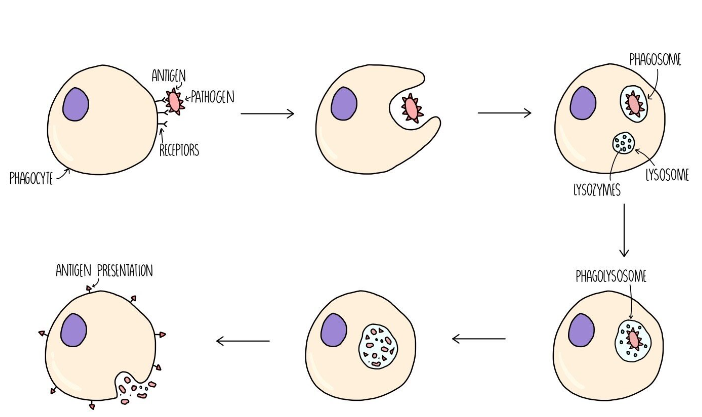
Where do T and B lymphocytes get produced and mature?
Both are produced in the bone marrow
B lymphocytes also mature in the bone marrow
T lymphocytes mature in the thymus gland
What are the four types of T lymphocytes and their roles?
T helper cells- release interleukins (a type of cytokine), that act as chemical signalling molecules, triggering clonal expansion of T cells and clonal selection of B cells
T killer/cytotoxic cells- kill infected body cells by producing perforin (makes holes in the cell membrane of infected cells)
T regulator/suppressor cells- suppress (down-regulate) the immune system after the pathogens have been destroyed to prevent an autoimmune response
T memory cells- remain in the blood, meaning that if the same pathogen returns the process of clonal selection will occur more quickly
What are the three types of B lymphocytes and their roles?
Plasma cells- produce specific antibodies
B effector cells- divide after activation in the humoral immune response to produce plasma cell clones
B memory cells- remain in the blood, meaning that if the same pathogen returns the process of clonal selection will occur more quickly
What is the process of the cell-mediated specific immune response?
Phagocytosis by macrophages produces an antigen-presenting cell
A T helper cell with a specific complementary receptor to the antigen binds during clonal selection
The activated T helper cell produces interleukins (a type of cytokine) which stimulate clonal expansion, where more T cell clones are produced by mitosis
The cloned T cells can develop into any T helper, memory or killer cells
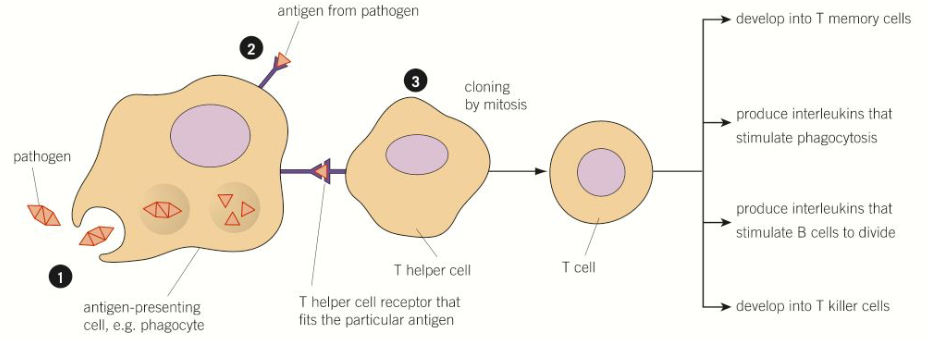
What is the process of the humoral specific immune response?
A specific B effector cell engulfs an antigen and becomes an antigen-presenting cell (APC)
T helper cells that have been activated during the cell-mediated response bind to the B cell APC, which is clonal selection
The interleukins (a type of cytokine) trigger the B cell to divide by mitosis, in clonal expansion, to become plasma cells and some B memory cells
These plasma cells produce specific antibodies that act against the pathogen
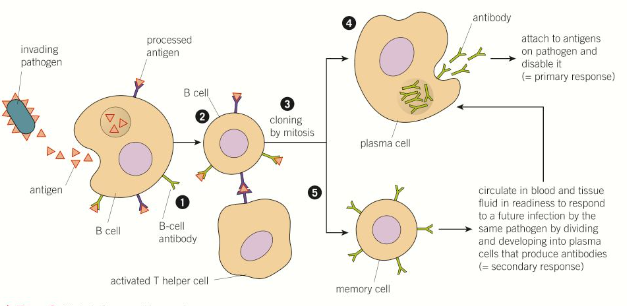
What are the primary and secondary immune responses?
The primary response is to a newly encountered antigen
The secondary response is to a previously encountered antigen
The primary response produces T and B memory cells, which remain in the blood for a long time
This means the process of clonal selection in the secondary response is much faster
B memory cells will divide and differentiate into plasma cells to produce antibodies (faster and in greater volumes than the primary response)
T memory cells will divide and differentiate into T killer and helper cells

What are antibodies and what are their roles?
Antibodies are globular glycoproteins called immunoglobulins, which bind specifically to antigens, and can act as:
Opsonins
Agglutinins
Antitoxins
What is the structure of antibodies?
Y-shaped molecule made up of 4 polypeptide chains- two ‘heavy’ and two ‘light’- joined by strong disulfide bridges
Consists of a constant region, which is the same in all antibodies, and a variable region, where the amino acid sequences vary between antibodies to let them bind to specific antigens (at the antigen-binding sites)
The hinge region (in the corner between the two heavy chains) gives the structure flexibility so that the Y shape can be at different angles to bind easier
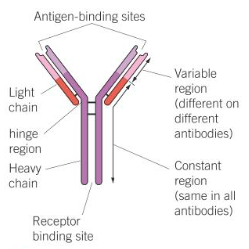
How can antibodies act as opsonins?
They can attach to pathogens and tag them so that they are more easily recognisable to phagocytes
How can antibodies act as agglutins?
They can bind to and clump pathogens together (agglutination), so they are more easily engulfed by phagocytes
How can antibodies act as antitoxins?
They can bind to the toxins produced by pathogens, neutralising them so that they are harmless
What is natural active immunity?
When a pathogen enters the body (natural) and triggers an immune response (active)
The memory lymphocytes produced cause immunity as the secondary response is much faster
What is artificial active immunity?
When an antigen enters the body by a vaccination (artificial) and triggers an immune response (active)
The memory lymphocytes produced cause immunity as the secondary response is much faster
What is natural passive immunity?
When a baby receives antibodies (passive) from the mother (natural)
This can be received across the placenta, for a foetus, or through colostrum in early breast milk, for newborn babies
What is artificial passive immunity?
When a person is given antibodies through an injection (artificial) and does not have an immune response (passive)
This is sometimes used for people infected with tetanus or rabies
How do vaccines work?
A safe form of antigen, from a pathogen that has been killed, inactivated or attenuated (weakened), is injected into a healthy person
This triggers an immune response resulting in the production of memory lymphocytes
These remain in the blood and respond quickly to a second exposure
They can provide lifelong or short term protection, in which case routine booster injections may be needed
How are vaccinations used to prevent epidemics?
Why do some have to be regularly changed?
Why doesn’t everyone in a population need to be vaccinated?
At the beginning of an epidemic, mass vaccination can prevent the pathogen from spreading further by making more people immune
Pathogens regularly mutate and change their antigens, making vaccines for previous strains useless, so new ones have to be developed regularly (eg. the flu)
When the majority of a population has been vaccinated, the chances of a non-vaccinated person encountering the pathogen are so low that they are not at risk- this is herd immunity, which is beneficial for people who cannot be vaccinated (eg. children and immunocompromised people)
What is an autoimmune disease? What are two examples?
An autoimmune disease occurs when the body attacks itself, because the antibodies or lymphocytes trigger an immune response against a self-antigen
Eg. Lupus- the connective tissue of the body is attacked, damaging several organs
Eg. Rheumatoid arthritis- the joints are attacked, causing joint pain and muscle spasms
What causes autoimmune diseases?
The cause is not known but we know:
Susceptibility to autoimmune diseases can be inherited and passed down through specific genes
It can also be triggered by the environment
Why is maintaining biodiversity important?
Many of our medicines are obtained from plants, bacteria and fungi
These plants are mainly tropical, which means deforestation and destruction of rainforest habitats pose a risk to us, as it could kill off a potential source of medicine
How could genetics affect clinical care?
We can look at the genomes of patients and pathogens, to tailor the drug used to the situation
People could undergo genetic screening to test whether they have a higher chance of developing specific diseases, so preventative measures could be taken
This is called pharmacogenomics/pharmacogenetics
What is synthetic biology?
We can genetically modify other organisms, like bacteria, to produce drugs for us
Why is antibiotic resistance developing?
Overuse of antibiotics
Use of antibiotics unnecessarily (eg. for viruses)
Use of antibiotics on livestock in farming
Patients not completing the full prescribed course
How can biodiversity be considered at different levels?
Habitat diversity- the number and range of habitats
Species biodiversity- the species richness and evenness within a habitat
Genetic biodiversity- the genetic variation within a species
What are species richness and species evenness?
Species richness is the number of different species within an ecosystem (Area 1 and 2 have the same species richness)
Species evenness is the distribution of individuals across the different species in an ecosystem (Area 1 has a higher species evenness)
Ecosystems with high species richness and evenness are usually more stable, eg. an ecosystem dominated by only a few species (like Area 2) is at high risk of collapsing if one species is wiped out by a pathogen
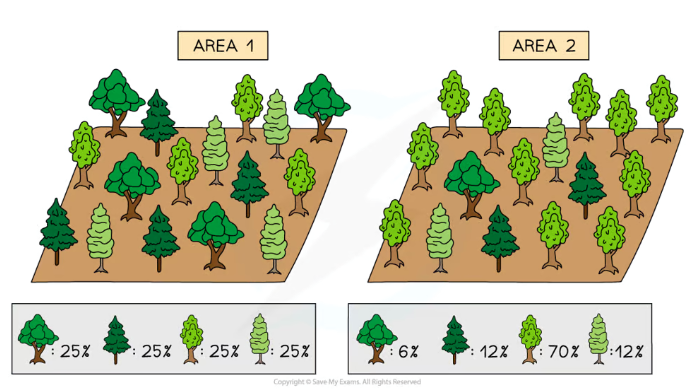
What sampling techniques can be used for organisms that can’t be sampled using quadrats?
Sweeping nets: used to catch flying insects by sweeping the net through long grass
Pitfall traps: jars are buried in the ground and catch insects and other invertebrates as they fall into the trap (canopies stop the trap from filling with rainwater)
Pooters: containers with two tubes sticking out- one is placed over the insect and the second tube is sucked to pull the insect into the container
Tullgren funnel: soil is placed into a funnel with a lightbulb above- insects will move down away from the light and drop into a container below
Kick-sampling: a riverbed is disturbed by kicking, and organisms in the sediment are carried by the water into the net
How can we assess levels of genetic diversity in isolated populations?
By calculating the proportion of genes in a genome that have multiple alleles (polymorphic loci)
P = the number of polymorphic gene loci ÷ total number of loci sampled
What are isolated populations?
Populations that have little to no genetic mixing with other organisms of the same species
This can be due to:
Captive breeding in zoos, where only a few captive individuals are available
Rare breeds and pedigree animals, where organisms are selectively bred together to favour desirable traits
Physical isolation, where populations have been geographically separated and can’t interact with each other
What factors affect biodiversity?
Human population growth has led to an increase in:
Agriculture often leads to deforestation, removal of hedgerows, monoculture, herbicides and pesticides, and eutrophication
Pollution
Climate change results in melting ice caps, rising sea levels, changes in weather conditions (including extreme weather like flooding and droughts), changes to bird migration and insect life cycles, and ocean acidification due to increased CO2 uptake
Fish farming
Hunting
What are the economic reasons for maintaining biodiversity?
Deforestation leads to soil erosion and desertification, which damages soils so they can’t be used to grow crops
Many medicines come from rainforest species, which could go extinct before we find them
Lack of diversity in croplands can lead to whole yields being destroyed by one disease or pest
Soil depletion due to monoculture strips soil of its nutrients so crops become less successful and healthy
Highly biodiverse areas promote tourism
What are the aesthetic reasons for maintaining biodiversity?
Biodiverse areas are popular for recreation, eg. walking, birdwatching, cycling
The natural world provides inspiration for creatives such as musicians and poets
Patients recover faster from surgery and injury in green areas
What are the ecological reasons for maintaining biodiversity?
A more genetically diverse ecosystem is better able to survive and adapt to environmental changes or threats
Organisms are very interdependent, so if one is killed off, it can affect many other organisms
This is particularly for keystone species, which play a major role in their ecosystems
What are the two methods of conservation?
In situ- within the natural habitat
Ex situ- outside of the natural habitat
What are the methods of in situ conservation?
Wildlife reserves- land is actively managed, including restricting human access, reintroducing species, prohibiting poaching, restricting industrial development, and removing invasive species
Marine conservation zones- areas of water are protected against overfishing and pollution (particularly coral reefs)
What are the methods of ex situ conservation?
Seed banks- seeds from many different species of plants are dried and frozen to maintain their ability to germinate, so they can be stored for long periods and can be used later on
Botanic gardens- plants are grown in ‘captivity’, under their ideal conditions, to keep populations alive, so they can be researched or reintroduction
Captive breeding programmes- zoos and aquariums maintain stable populations of endangered animal species so they can later be released into the wild (sometimes not possible due to domestication)- genetic diversity is maintained by breeding species from across a network of zoos
What conservation agreements have been made?
The Rio Convention on Biological Diversity (CBD) was signed by many countries in 1992 to implement strategies to maintain diversity with sustainable development and conservation
The Convention on International Trade in Endangered Species (CITES) is a global agreement that regulates and restricts the trade of at-risk species and their products eg. ivory
The Countryside Stewardship Scheme (CSS) is an initiative local to England, providing funding to farmers and landowners to incentivise conservation in their land management (this has been replaced by the similar Environmental Stewardship Scheme)
What is the order of taxonomical classification? What is a mnemonic to remember it?
Dear- domain
Kevin- kingdom
Please- phylum
Come- class
Over- order
For- family
Great- genus
Scones- species
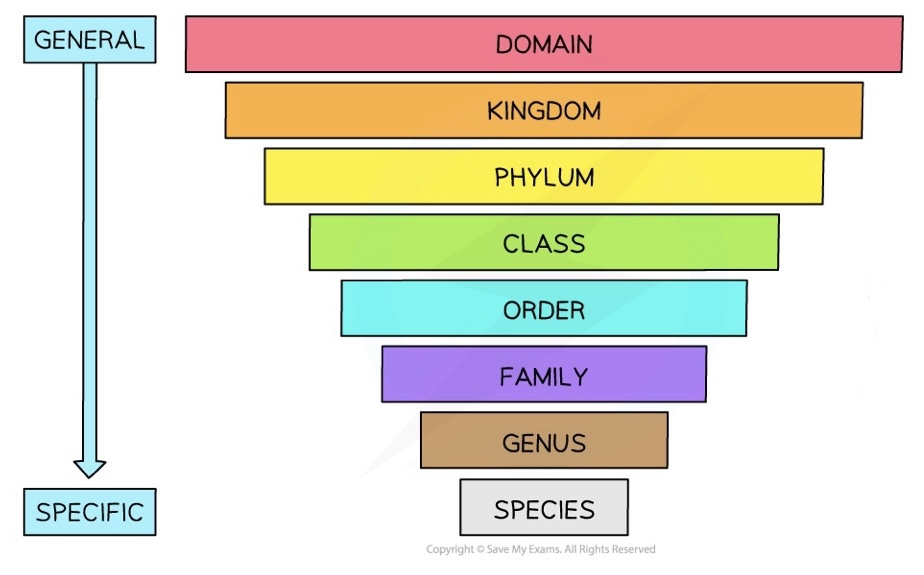
What is binomial classification?
Each organism is named using two Latin words eg. Canis lupus
The first word (capitalised) is the genus
The second word is the species
The name should be italicised or underlined (if handwritten)
What is a species?
A group of organisms that are able to reproduce to produce fertile offspring
Why is the binomial classification system useful?
They allow for species to be universally identified
The binomial for a species is the same across the globe
What led to the introduction of the three domain system?
Advances in molecular biology, biochemistry and cell structure showed that the prokaryotes are not one singular group
Molecular analysis of ribosomal RNA, protein synthesis, responses to antibiotics, and the structure of cell membranes and flagella led to the division of prokaryotes into bacteria and archaea
What are the three domains? What kingdoms make up each domain?
Bacteria- includes kingdom bacteria
Archaea- includes kingdom archaea
Eukarya- includes kingdoms protoctista, plantae, fungi and animalia

Describe the archaea domain
Prokaryotic (have no nucleus or membrane bound organelles )
Circular DNA
70S ribosomes
No cytoskeleton
Unique membrane lipids
No peptidoglycan in their cell walls
RNA polymerase made up by 8-10 proteins
Describe the bacteria domain
Prokaryotic (have no nucleus or membrane bound organelles )
Circular DNA
70S ribosomes
No cytoskeleton
Have peptidoglycan in their cell walls
RNA polymerase made up by 5 proteins
Describe the eukarya domain
Eukaryotic (have a membrane-bound nucleus and organelles)
Linear DNA
80S ribosomes
Have cytoskeleton
No peptidoglycan in their cell walls
RNA polymerase made up by 12 proteins
Describe the animalia kingdom
Part of the eukarya domain
Eukaryotic
No cell wall
Multicellular
Heterotrophic feeders
Store glucose as glycogen
Describe the plantae kingdom
Part of the eukarya domain
Eukaryotic
Multicellular
Cellulose cell wall
Autotrophic feeders (via photosynthesis)
Store glucose as starch
Describe the fungi kingdom
Part of the eukarya domain
Eukaryotic
Chitin cell wall
Can be multi or unicellular
Saprophytic, heterotrophic feeders
Store glucose as glycogen
Describe the protoctista kingdom
Part of the eukarya domain
Eukaryotic
Unicellular (can be in colonies)
Autotrophic or heterotrophic feeders
Describe the old prokaryotae kingdom
Prokaryotic
Unicellular
Circular DNA
Heterotrophic or autotrophic feeders
Peptidoglycan cell wall
What are heterotrophs?
Organisms that can’t produce their own food
They use compounds made by other organisms as their source of energy
Heterotrophs include saprophytes (eg. fungi), which rely on dead/decaying matter for food, and parasites
Eg. fungi (saprophytic), animals, some protoctists
What are autotrophs?
Organisms that can produce their own food
Most do so via photosynthesis
Eg. plants, some bacteria and protoctists
What is phylogeny?
The study of the evolutionary history and relationships of organisms
Why is it good to use phylogenetic classification over Linnaean classification?
Phylogenetic trees are continuous, rather than in discrete taxonomical groups- meaning we aren’t forced to put organisms in groups they don’t quite fit
The hierarchy of Linnaean classification can be misleading eg. implies two groups in the same rank have the same age, biodiversity and number of species
Phylogenetic tree
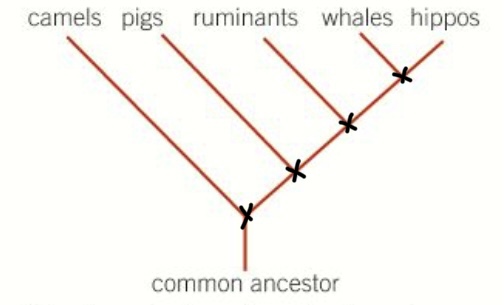
How was the theory of evolution by natural selection developed?
Charles Darwin and Alfred Wallace conducted independent studies across the world into the variation between species before publishing a paper together proposing the theory of natural selection
What evidence is there for evolution by natural selection?
The fossil record
Comparative anatomy
Comparative biochemistry
How can the fossil record be used as evidence for evolution by natural selection?
Fossils, and the rocks they are found in, can be dated (less recent layers are deeper in the ground)
This lets us accurately order extinct species into a sequence from oldest to youngest, to see how they changed through time
This also shows similarities between extinct and living species to see how they have evolved to be better suited for survival
However, the fossil record is incomplete as they are unlikely to form and have not all been found
How can comparative anatomy be used as evidence for evolution by natural selection?
Related species share homologous structures, eg. the pentadactyl limb
Homologous structures appear different, and may have different purposes, but have the same underlying structure
This suggests that the species evolved from a common ancestor that also had that homologous structure
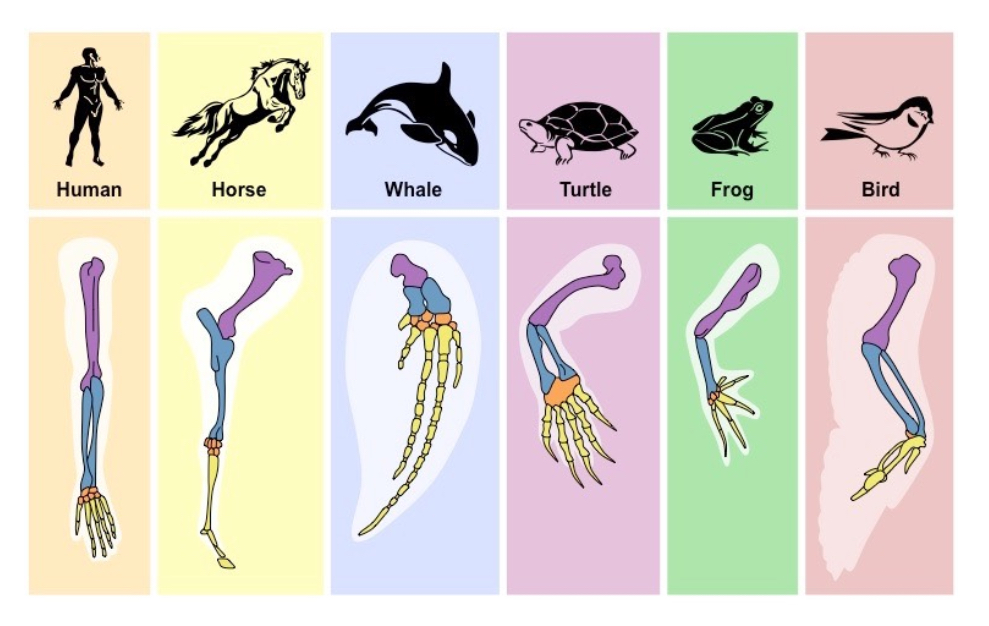
How can comparative biochemistry be used as evidence for evolution by natural selection?
The bases in DNA strands and the amino acids in proteins can be sequenced
The differences between these sequences in the equivalent genes of different species can show how closely related they are:
The more similar the sequence the more closely related the species are
Ribosomal RNA and cytochrome c, a protein involved in respiration, are the most commonly compared, as they are almost universal

What are the two types of species variation?
Interspecific- variation between different species
Intraspecific- variation between individuals in the same species
What are continuous and discontinuous variation? What causes them?
Continuous- can be any value across a range eg. between 1 and 10
Caused by more than two genes (polygenic) and often by environmental factors
Discontinuous- falls into discrete groups eg. red or green
Caused only by one gene
What are the different types of adaptations?
Anatomical
Structural or physical features
Eg. Having spines, camouflage, thick fur
Physiological
Biological processes
Eg. Producing poison or antibiotics, holding water
Behavioural
How an organism acts
Eg. Being nocturnal, migration, courtship rituals
What is convergent and divergent evolution? Give an example of each
Divergent evolution- when species appear similar because they inherited traits from a recent common ancestor
Eg. the pentadactyl limb
Convergent evolution- when species appear similar due to having adapted certain traits for their habitat, even though they don’t share a recent common ancestor
Eg. the marsupial vs placental mole
What is the process of evolution by natural selection?
There’s variation in the population due to mutations introducing new alleles
A selection pressure (change in environment eg. climate, disease, food availability) kills off most of the population
Certain individuals have alleles that are advantageous and they survive
These individuals breed and their offspring inherit the beneficial alleles
Over many generations this repeats and the frequency of the trait in the population increases
How can a population evolve antibiotic or pesticide resistance?
There’s variation in the population due to mutations introducing new alleles
The antibiotic or pesticide acts as a selection pressure and kills off most of the population
Certain individuals have resistant alleles that are advantageous and they survive
These individuals breed and their offspring inherit the resistant alleles
Over many generations this repeats and the frequency of resistance in the population increases